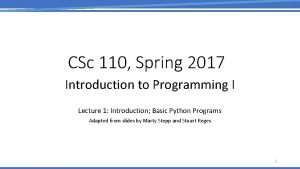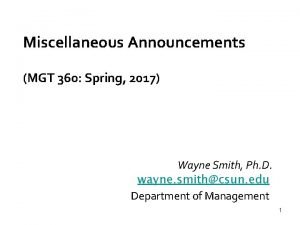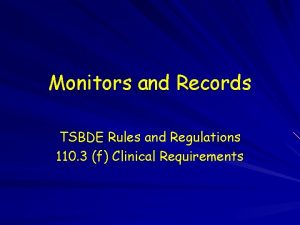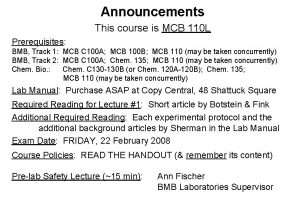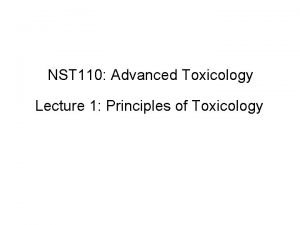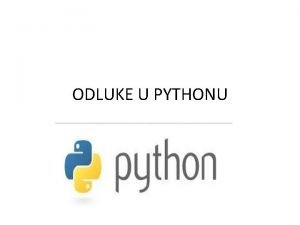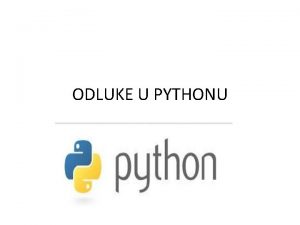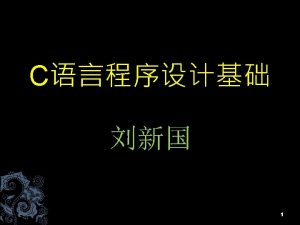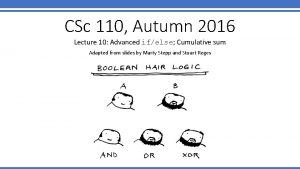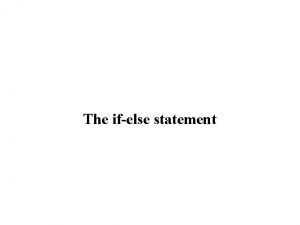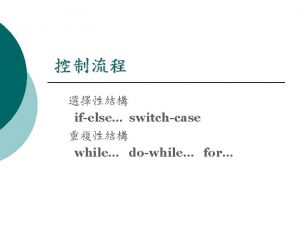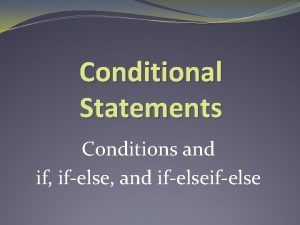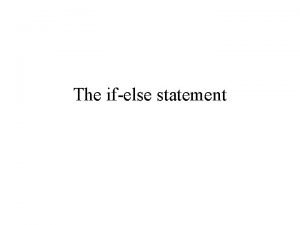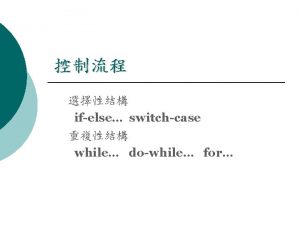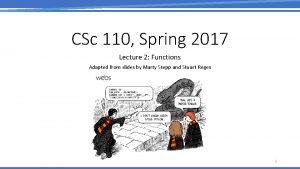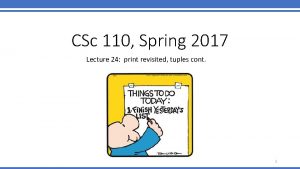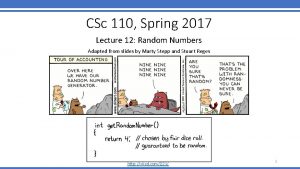CSc 110 Spring 2017 Lecture 9 Advanced ifelse

















- Slides: 17

CSc 110, Spring 2017 Lecture 9: Advanced if/else; Cumulative sum Adapted from slides by Marty Stepp and Stuart Reges 1

Nested if/else question • Write a program that produces output like the following: This program reads data for two students and computes their Computer Science GPAs Enter next person's information: CS 110 grade? A CS 120 grade? B Enter next person's information: CS 110 grade? B CS 120 grade? B Person 1 GPA = 3. 5 accepted Person 2 GPA = 3. 0 accepted Difference = 0. 5 Grade A B C D GPA 4. 0 3. 0 2. 0 1. 0

Factoring if/else code • factoring: Extracting common/redundant code. • Can reduce or eliminate redundancy from if/else code. • Example: if (a == 1): print(a) x = 3 b = b + x elif (a == 2): print(a) x = 6 y = y + 10 b = b + x else: # a == 3 print(a) x = 9 b = b + x print(a) x = 3 * a if (a == 2): y = y + 10 b = b + x 3

Relational Operators • if statements use logical tests. if (test) : • These are boolean expressions. • relational operators produce boolean values of True or False Operator Meaning Example Value == equals 1 + 1 == 2 True != does not equal 3. 2 != 2. 5 True < less than 10 < 5 False > greater than 10 > 5 True <= less than or equal to 126 <= 100 False >= greater than or equal to 5. 0 >= 5. 0 True 7

Logical operators • Tests can be combined using logical operators • logical operators produce Boolean values of True or False Operator and Description and Example (2 == 3) and (-1 < 5) Result False or or (2 == 3) or (-1 < 5) True not not (2 == 3) True • "Truth tables" for each, used with logical values p and q: p and q p or q p True q True False p True False not p 8

Evaluating logical expressions • Precedence: 1 - arithmetic operators 2 - relational operators 3 - logical operators • Example: 5 * 7 >= 35 >= True and True 3 + 5 * (7 – 1) and 7 <= 11 3 + 5 * 6 and 7 <= 11 3 + 30 and 7 <= 11 33 and 7 <= 11 True 9

Evaluating Logical expressions • What is the result of each of the following expressions? x = 42 y = 17 z = 25 • • • y < x and y <= z x % 2 == y % 2 or x % 2 == z % 2 x <= y + z and x >= y + z not(x < y and x < z) (x + y) % 2 == 0 or not((z - y) % 2 == 0) • Answers: True, False, True, False 10

Using Logical operators • Determine if an integer specified by the user falls within the range of the variables high and low. n = int(input("Enter a number: ")) if (n >= low and n <= high): print(str(n) + " is in range") • Write a program that prompts the user for a number. Print Fizz if the number is divisible by 3 Print Buzz if the number is divisible by 5 Print Fizz. Buzz if the number is divisible by 3 and 5 11

Cumulative algorithms 12

Adding many numbers • How would you find the sum of all integers from 1 -10? # This requires a lot of typing sum = 1 + 2 + 3 + 4 + 5 + 6 + 7 + 8 + 9 + 10 print("The sum is " + str(sum)) • What if we want the sum from 1 - 1, 000? (Too much typing…) Or the sum up to any maximum? • How can we generalize the above code? 13

Cumulative sum loop sum = 0 for i in range(1, 11): sum = sum + i print("The sum is " + str(sum)) • cumulative sum: A variable that keeps a sum in progress and is updated repeatedly until summing is finished. • The sum in the above code is an attempt at a cumulative sum. • Cumulative sum variables must be declared outside the loops that update them, so that they will still exist after the loop. 14

Cumulative product • This cumulative idea can be used with other operators: product = 1 for i in range(1, 21): product = product * 2 print("2 ^ 20 = " + str(product)) • How would we make the base and exponent adjustable? 15

input and cumulative sum • We can do a cumulative sum of user: sum = 0 for i in range(1, 101): next = int(input("Type a number: ")) sum = sum + next } print("The sum is " + str(sum)) 16

Cumulative sum question • Modify the Receipt program we saw in lecture 3 • Prompt for how many people, and each person's dinner cost. • Use functions to structure the solution. • Example log of execution: How many people ate? 4 Person #1: How much did Person #2: How much did Person #3: How much did Person #4: How much did your dinner cost? 20. 00 15 30. 0 10. 00 Subtotal: $75. 0 Tax: $6. 0 Tip: $11. 25 Total: $92. 25 17

Cumulative sum answer # This program enhances our Receipt program using a cumulative sum. def main(): subtotal = meals() results(subtotal) # Prompts for number of people and returns total meal subtotal. def meals(): people = int(input("How many people ate? ")) subtotal = 0. 0 # cumulative sum for i in range(1, people + 1): person_cost = float(input("Person #" + str(i) + ": How much did your dinner cost? ")) subtotal = subtotal + person_cost; # add to sum return subtotal. . . 18

Cumulative answer, cont'd. # Calculates total owed, assuming 8% tax and 15% tip and prints a receipt def results(subtotal): tax = subtotal *. 08 tip = subtotal *. 15 total = subtotal + tax + tip print("Subtotal: print("Tax: $" + print("Tip: $" + print("Total: $" $" + str(subtotal)) str(tax)) str(tip)) + str(total)) 19

if/else, return question • Write a function count_factors that returns the number of factors of an integer. • count_factors(24) returns 8 because 1, 2, 3, 4, 6, 8, 12, and 24 are factors of 24. • Solution: # Returns how many factors the given number has. def count_factors(number): count = 0 for i in range(1, number + 1): if (number % i == 0): count = count + 1 # i is a factor of number return count 20
 Vignette mutuelle 110/110
Vignette mutuelle 110/110 110-000-110 & 111-000-111
110-000-110 & 111-000-111 Csc 110 university of arizona
Csc 110 university of arizona 01:640:244 lecture notes - lecture 15: plat, idah, farad
01:640:244 lecture notes - lecture 15: plat, idah, farad Csun spring 2017
Csun spring 2017 Ftp server spring 2017
Ftp server spring 2017 Cast of spring, summer, fall, winter... and spring
Cast of spring, summer, fall, winter... and spring Autumn winter summer
Autumn winter summer Smx advanced 2017 slides
Smx advanced 2017 slides Advanced inorganic chemistry lecture notes
Advanced inorganic chemistry lecture notes Preterite regular verbs
Preterite regular verbs Introduction to physics 110
Introduction to physics 110 Tsbde rules and regulations chapter 110
Tsbde rules and regulations chapter 110 Mcb 110
Mcb 110 Toxicology effects
Toxicology effects Cis 110 syllabus
Cis 110 syllabus Ece 211
Ece 211 Psalm 110 1
Psalm 110 1


